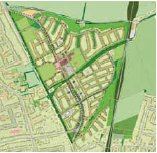
Barton Farm Development Plan
Barton Farm Public Inquiry - TrustNews Mar 11
The Public Inquiry into Cala Homes proposal for 2000 homes at Barton Farm is taking place as this TrustNews goes to press. The Trust is following the proceedings closely and Michael Carden has presented the following statement on behalf of the Trust.
- The Trust is the civic society for Winchester town, founded in 1957 as the Winchester Preservation Trust but subsequently changing its name to avoid the impression that we are opposed to change. We have always held that what we aim to preserve is the character of the City and that much of its character has been derived from continuing change over the years, which should not be arbitrarily halted in any particular period. Our concern therefore is that change should be managed to retain and enhance the City’s character. The Trust has some 800 members with an administrative council of 15.
- We regard the Barton Farm development to be of an unprecedented scale for the periodic growth of the City, with a number of harmful implications for its Infrastructure, which (apart from an aspect of affordable housing to be dealt with in a statement by Harvey Cole) are all mentioned by other groups and individuals, so that heeding your request I shall not repeat them. But we must stress the effect of filling-in one of the ‘green wedges’ that are fundamental to the exceptional landscape setting of the City that Kim Wilkie, the internationally renowned landscape architect, regards as unique in this country and only surpassed in Europe by the city of Florence. In his summary for the SBF Group Gavin Blackman called for national recognition and protection of the remaining towns that have such settings. Quite independently the Trust has embarked on a campaign to introduce via Civic Voice (the successor to the Civic Trust), legislation for what we have called Heritage Town Status with similar characteristics to the successful Conservation Area legislation that halted the well-intentioned but disastrous destruction of our town and village centres 50 years ago.
- Finally, we noted your question about the City’s commendable Blueprint initiative and Nigel Green’s reply. We should like to add that the City of Winchester Trust joined with two other groups (Winchester Action on Climate Change and Winchester Area Community Action) to respond to the City’s invitation that, in the absence of a town council, we should give our views on the future development of the City. In addition to a series of intensive joint group meetings to study the issues, we held an open meeting to test our conclusions in public. The resulting written response was returned to the Council. I will only quote one of the five recommendations:
“Before the LDF is written all existing evidence, together with further predictions, should be drawn together in the form of a comprehensive Urban Capacity Report, which is in an accessible form for public engagement, showing all potential urban land in the City and surrounding villages that might become a vailable for development. The object is to show the extent to which housing and commerce might be contained within the urban areas, and to assess how much additional green field land might be required.” - This we believe is the essence of Localism; it would be premature to prejudice its influence by allowing such a huge development as Barton Farm to proceed on the basis of out-of-date, gap-filling planning criteria that permit extravagant use of land. Soon-to-be-necessary sustainable densities could more than halve the land-take and potentially save the ‘wedge’ and reduce the wider use of open land.
Following Michael Carden’s evidence, Harvey Cole presented a statement on behalf of the Trust regarding affordable homes. He argued convincingly that Cala’s claim that the provision of affordable homes was a major justification for the development was unfounded because the numbers could not solve the growing shortfall. Nevertheless he urged that if the development were approved, there should be a condition that the 40% proportion of affordable homes must be provided at each phase of the development and not left to the end.
